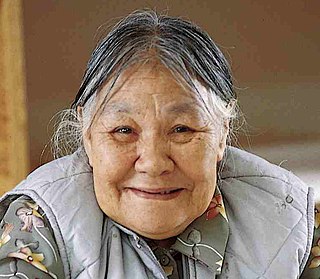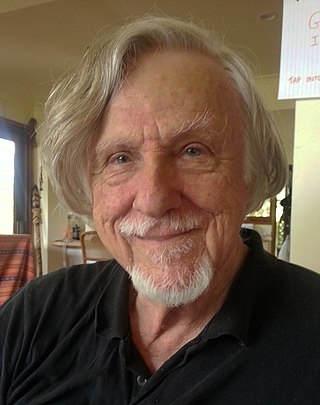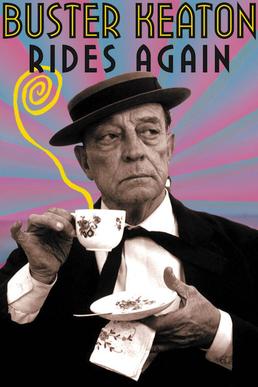Related Research Articles
Roman Kroitor was a Canadian filmmaker who was known as a pioneer of Cinéma vérité, as the co-founder of IMAX, and as the creator of the Sandde hand-drawn stereoscopic 3D animation system. He was also the original inspiration for The Force. His prodigious output garnered numerous awards, including two BAFTA Awards, three Cannes Film Festival awards and two Oscar nominations.
Universe is a black-and-white animated documentary short film made in 1960 by the National Film Board of Canada. It "creates on the screen a vast, awe-inspiring picture of the universe as it would appear to a voyager through space. Realistic animation takes you into far regions of space, beyond the reach of the strongest telescope, past Moon, Sun, and Milky Way into galaxies yet unfathomed."

Arthur Lipsett was a Canadian filmmaker with the National Film Board of Canada. His short, avant-garde collage films, which he described as "neither underground nor conventional”, contain elements of narrative, documentary, experimental collage, and visual essay. His first film, Very Nice, Very Nice, was nominated for an Academy Award.
Robin Spry was a Canadian film director, producer and writer. He was perhaps best known for his documentary films Action: The October Crisis of 1970 and Reaction: A Portrait of a Society in Crisis about Quebec's October Crisis. His 1970 film Prologue won the BAFTA Award for Best Documentary.

Kenojuak Ashevak,, is celebrated as a leading figure of modern Inuit art.

Michael Dattilo Rubbo is an Australian documentarian/filmmaker.
Don Owen was a Canadian film director, writer and producer who spent most of his career with the National Film Board of Canada (NFB). His films Nobody Waved Good-bye and The Ernie Game are regarded as two of the most significant English Canadian films of the 1960s.
John Feeney was a New Zealand-born director, photographer and writer.
Colin Archibald Low was a Canadian animation and documentary filmmaker with the National Film Board of Canada (NFB). He was known as a pioneer, one of Canada's most important filmmakers, and was regularly referred to as "the gentleman genius". His numerous honors include five BAFTA awards, eight Cannes Film Festival awards, and six Academy Award nominations.

Buster Keaton Rides Again is a 55-minute 1965 documentary film directed by John Spotton and narrated by Michael Kane. The film is a behind-the-scenes documentary shot while Buster Keaton's film The Railrodder (1965), was being produced. Although it is a production documentary, the film is actually longer than The Railrodder, which was only 24 minutes long. Both films were produced by the National Film Board of Canada (NFB). A French version of Buster Keaton Rides Again, Avec Buster Keaton was also released.
Hugh O'Connor was a Canadian television journalist and documentary filmmaker, who worked for the National Film Board of Canada (NFB). He was murdered while filming in Kentucky in 1967.
The Living Stone is a 1958 Canadian short documentary film directed by John Feeney and produced by the National Film Board of Canada. It shows the inspiration behind Inuit sculpture, where the aim of the artist is to release the image he or she sees imprisoned in the stone. Among its numerous honours was a nomination, at the 31st Academy Awards, for Best Documentary Short Film.
Blackwood is a 1976 Canadian short documentary film about Newfoundland artist David Blackwood, directed by Tony Ianzelo and Andy Thomson and narrated by Gordon Pinsent.

Gerald Potterton was a Canadian director, animator, producer and writer. He is best known for directing the cult classic Heavy Metal and for his animation work on Yellow Submarine.

Joseph (Joe) Koenig is a Canadian filmmaker and entrepreneur who was the founder and president of Electronics Workbench.
John Spotton C.S.C. was a Canadian filmmaker with the National Film Board of Canada.
Mort Ransen was a Canadian film and television director, editor, screenwriter and producer, best known for his Genie Award-winning 1995 film Margaret's Museum.
John Kemeny was a Hungarian-Canadian film producer whom the Toronto Star called "the forgotten giant of Canadian film history and...the most successful producer in Canadian history." His production credits include The Apprenticeship of Duddy Kravitz, Atlantic City, and Quest for Fire.

Albert Kish was a Canadian documentarian/filmmaker.
Morten Parker was a Canadian director, producer and writer.
References
- ↑ "Eskimo Artist: Kenojuak". onf-nfb.gc.ca. National Film Board of Canada. Retrieved January 22, 2023.
- ↑ "The 37th Academy Awards (1965) Nominees and Winners". oscars.org. Retrieved August 24, 2011.
- ↑ "Eskimo Artist: Kenojuak". nfb.ca. National Film Board of Canada. Retrieved January 23, 2023.
- ↑ "Eskimo Artist: Kenojuak". onf-nfb.gc.ca. National Film Board of Canada. Retrieved January 22, 2023.